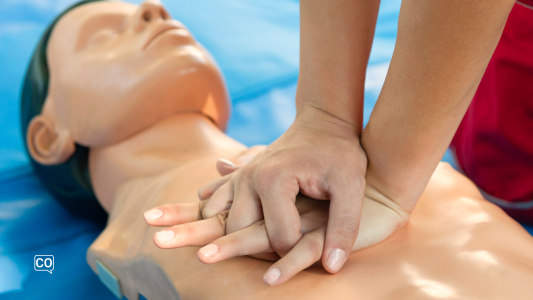Exercise 1: Text
Instruction: 1. Read the text in pairs. 2. Memorize the phrases by covering the translation.
El conjunto de maniobras de primeros auxilios de RCP o Reanimación Cardiopulmonar.
The set of first aid manoeuvres for CPR or Cardiopulmonary Resuscitation.
| Aprender lo básico de la RCP es muy importante porque puede salvar vidas. | (Learning the basics of CPR is very important because it can save lives.) |
| Se utiliza cuando una persona deja de respirar. | (It is used when a person stops breathing.) |
| Primero, tienes que encontrar el lugar correcto para colocar las manos: en el centro del pecho. | (First, you have to find the correct place to place your hands: in the center of the chest.) |
| Coloca una mano encima de la otra y presiona con fuerza, empujando hacia abajo y luego dejando que el pecho suba. | (Place one hand on top of the other and press firmly, pushing down and then letting the chest rise.) |
| Las compresiones deben ser firmes y rápidas, con un ritmo constante. | (Compressions should be firm and fast, with a steady rhythm.) |
| Si la persona no respira, también tienes que hacer respiraciones boca a boca para ayudar a sus pulmones. | (If the person isn't breathing, you also have to do mouth-to-mouth breaths to help their lungs.) |
| Si no hay respuesta, sigue haciendo las compresiones y las respiraciones con calma y determinación. | (If there is no response, keep doing the compressions and breaths calmly and determinedly.) |
| Mantener el ritmo correcto y no rendirse es fundamental para dar una oportunidad de sobrevivir. | (Maintaining the correct rhythm and not giving up is essential to give a chance to survive.) |
Exercise 2: Questions about the text
Instruction: Read the text above and choose the correct answer.
1. ¿Por qué es importante aprender la RCP básica?
(Why is it important to learn basic CPR?)2. ¿Qué parte del cuerpo debes proteger primero según el texto?
(Which part of the body should you protect first according to the text?)3. ¿Dónde se deben colocar las manos para hacer las compresiones?
(Where should the hands be placed to perform compressions?)4. ¿Qué debes hacer si la persona no respira durante la RCP?
(What should you do if the person does not breathe during CPR?)Exercise 3: Open conversation questions
Instruction: Discuss the following questions with your teacher using the vocabulary from this lesson, and write down your answers.
- ¿Por qué es fundamental proteger el corazón durante la RCP?
- ¿Cómo debes colocar las manos para hacer las compresiones en el pecho?
- ¿Qué puedes hacer para ayudar a los pulmones si la persona no respira?
- ¿Crees que es importante conocer la anatomía para realizar la RCP correctamente? ¿Por qué?
Why is it essential to protect the heart during CPR?
How should you place your hands to perform chest compressions?
What can you do to help the lungs if the person is not breathing?
Do you think it is important to know the anatomy to perform CPR correctly? Why?
